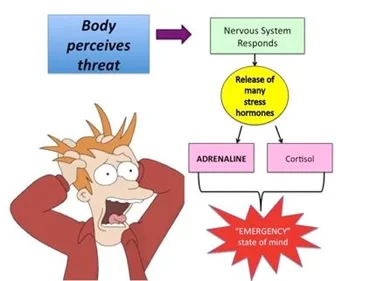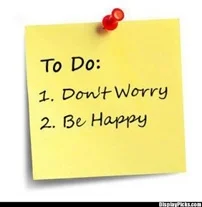Anatomy and Physiology of Anxiety. Anxiety: Part 3/7
This is Part 3 of our series of articles on anxiety.
There are three main ingredients to anxiety:
1. Thoughts
When we feel threatened, our attention is focused on the perceived threat. (Perceived is the key word - remember the overly sensitive car alarm? The threat can be real or nonexistent. As long as we perceive it as dangerous, we are on high alert).
Our perception of a situation mostly depends on what we say to ourselves about it. Anxiety-related perceptions and thoughts revolve around the themes of danger (physical, mental, or social), threat, or vulnerability.
Examples of anxiety-producing thoughts are:
Everybody will think I'm stupid
Something is very wrong with my body
What if I make a fool of myself?
Dogs are dangerous and will attack and bite
What if something happens to my child?
I will fail this test
What if my friend rejects me?
Our brain interprets these thoughts as a signal to prepare for danger. Since we are preoccupied with focusing on survival, we have difficulty concentrating on anything else.
“Our perception of a situation mostly depends on what we say to ourselves about it.”
Students that are anxious about academic performance have difficulty focusing on the exam questions. People that are anxious about social situations can't follow a conversation. And people with panic disorder are so hyper-aware of their physical symptoms that they can hardly attend to anything else.
Speaking of physical symptoms. Those, by themselves, are another component of anxiety:
2. Physical Sensations
Remember the Fight/Flight Response (the Sympathetic Nervous System) from Part I of this article? When it gets activated, it causes your adrenal glands to release two hormones - adrenaline and noradrenaline. This leads your body to respond in several ways:
Increased heart rate. This happens because your heart and vital organs need more oxygen and better blood supply.
Rapid breathing (hyperventilation) - you need to breathe much faster so that more oxygen is delivered to major organs.
Feeling dizzy or lightheaded. This is the natural response to hyperventilation, as there's suddenly too much of the good thing (oxygen) in the body. Another reason is that most of the oxygen goes toward the muscles, so there's a little less left for your brain, which results in a feeling of dizziness.
Tightness and pain in the chest as all of your muscles tense in preparation for danger. Again, the blood flows away from the peripheral areas to the major muscle groups (e.g., from our fingers to our arms).
Upset stomach or nausea (especially in kids, tummy aches are very common). The time of danger is not the time for leisurely digesting your dinner. The energy is needed for other parts of the body.
Sweating. To cool your body and to make it more slippery so that it's more difficult to grab you in case of a fight. (Isn't that cool?)
Numbness or tingling in fingers and toes because of the blood flow away from these areas.
Choking sensation. Again, muscle tension.
Feeling unreal. This relates to your pupils dilating so that you can see better, which may lead to a strange feeling of unreality. This may also be related to that diminished oxygen supply to the brain.
As unpleasant and dangerous as those symptoms may be, they actually represent the wonderful survival system of your body. So, when patients with anxiety describe some of these symptoms to us, we usually congratulate them on being healthy!
3. Behaviours
When faced with danger, our natural response is to escape. After escaping, we usually feel relieved. In the future, we try to avoid the situation that we perceived as dangerous. We also try to make ourselves as safe as possible when we can't escape the situation.
All of those components of anxiety (Thoughts, Physical Sensations, and Behaviours) are interconnected:
The more of those anxious thoughts we have, the more severe our physical reactions will be, and the higher our desire to escape and be safe will be.
The more physical reactions we experience, the more anxiety-related thoughts we will have, and the more we will try to avoid the situation.
And, the more we attempt to escape or be safe, the more we will attribute dangerousness to the situation (via our thoughts), and the more severe our physical responses will become.
So, all three components of anxiety create a vicious cycle, with each element influencing the other two.
But here's the good news: In a similar way, if we address any one of the anxiety components, the other two will also start diminishing.
How do we do it? In Part 4 of this article, we will review dealing with each of the anxiety components. But first,
A few words about what DOES NOT help:
Well-meaning friends and family members (as well as numerous positive-thinking-oriented self-help books) tend to provide us with advice and "useful" tips such as:
Don't worry, everything will be okay.
Think positively.
Just try to be calm.
If you think about negative stuff, bad things are more likely to happen.
You are strong!
Believe in yourself!
I also worry sometimes, but then I think about the good things and my worries go away.
Relax!
If you have already tried those, you know that they don't work. And if you are at the stage where you are considering trying them, let me save you time and spare you from disappointment. Instead, please read on. In Part 4 you will learn some evidence-based CBT strategies to deal with anxiety.
If you enjoyed this article, follow me on Facebook for more great tips and resources!
Anna Prudovski is a Psychologist and the Clinical Director of Turning Point Psychological Services. She has a special interest in treating anxiety disorders and OCD, as well as working with parents.
Anna lives with her husband and children in Vaughan, Ontario. When she is not treating patients, supervising clinicians, teaching CBT, and attending professional workshops, Anna enjoys practicing yoga, going on hikes with her family, traveling, studying Ayurveda, and spending time with friends. Her favorite pastime is reading.
Related Posts














